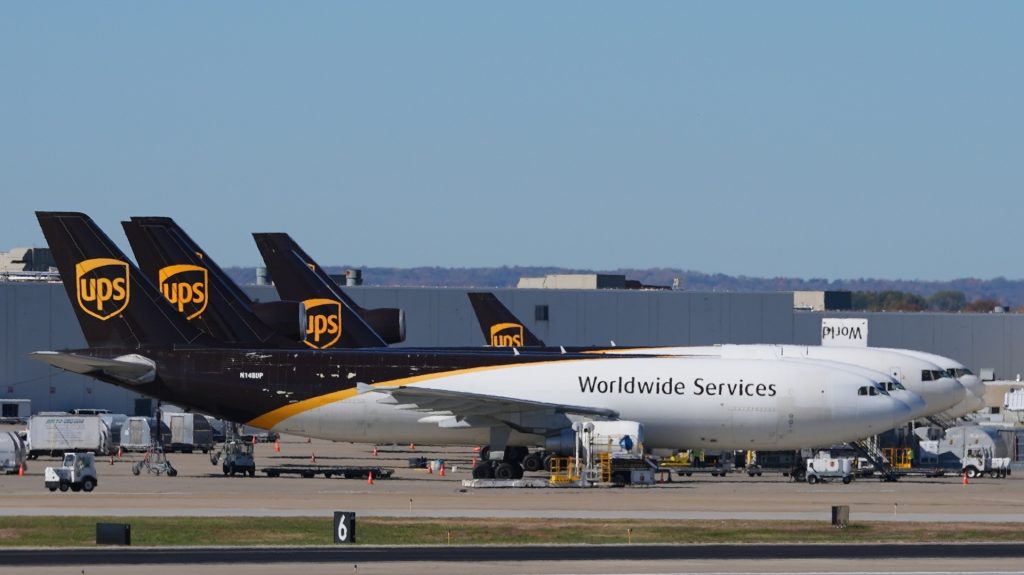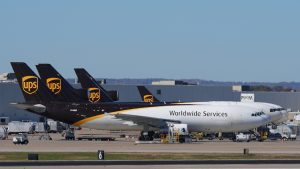Cargo and passenger jets fly the same skies, but don’t crash at the same rate

The crash of a UPS plane last week in Louisville, Kentucky, brought renewed attention to a little-noticed issue in the aviation world: cargo aircraft safety. While data is often conflicting, pilots and aviation safety advocates say such planes are more likely to crash than passenger aircraft and need attention for safety upgrades.
“There’s a number of ways to slice the data,” Alan Levin, a freelance aviation safety journalist, told NPR in 2013. “But any way you look at it, cargo is having more accidents, at least as far as the rate of accidents per flight.”
Freight planes fly just 1/10 as many flights as passenger craft. But the flights are longer, Levin said, and the planes crash more often.
The Louisville crash illustrated the dangers. The plane, headed to Hawaii, crashed moments after takeoff Nov. 4 from the UPS air transport headquarters, killing at least 12 people, most of them on the ground. The casualties were exceptionally high for a cargo aircraft that typically has a crew of less than five on board.
Parsing the data
Tracking precisely how often cargo planes crash is a complicated task. Data from the International Air Transport Association, the U.S. Department of Transportation and other sources often conflict.
But the International Air Transport Association, a global airline trade association, said in its latest annual safety report that cargo planes were involved in 16 of 29 fatal crashes in North America from 2005 to 2025. The ratio of fatal cargo plane crashes to passenger plane crashes was 4:3.
The IATA has tracked the rates since 2005, but getting a full picture requires parsing thousands of data points from multiple sources. The most thorough source on aircraft accidents, the National Transportation Safety Board, doesn’t delineate aircraft by passenger or freight in its monthly accident reports.
However, the Flight Safety Foundation raised concerns in 2018 about a lack of attention to fatal cargo crashes. The previous year, those crashes caused 29% of 49 reported deaths from aircraft accidents, a number far disproportionate to the number of flights. According to the foundation’s global accident dashboard, 33 fatal aviation accidents occurred in the U.S. between 2019 and 2024 — 11 on cargo flights, two on scheduled passenger flights and the rest on general aviation planes.
During that same five-year period, a total of 347 aviation accidents were reported: 158 on passenger flights, 49 on cargo flights and 140 in other types of flights.
Those accidents included an Amazon-operated Boeing 767-300 aircraft that crashed in Texas, killing all three people aboard on Feb. 23, 2019. An NTSB investigation found probable cause for several factors that led to the crash, including errors by the pilot and first officer, and deficiencies in the aviation industry and the FAA.
Aircraft, safety upgrades slow for cargo planes
Cargo planes receive upgrades less frequently than passenger planes, and Levin said freight aircraft crashes occur at higher rates in part because those flights are less regulated than passenger flights.
“For example, just a year and a half ago, after decades of struggle, the U.S. put in place new rules to prevent fatigue in pilots, but they exempted the cargo pilots,” Levin said in 2013. “The reason for this is, basically, every time the federal government creates a new rule, they have to justify it on a cost-benefit analysis.”
Joe DePete, a former FedEx Express pilot, testified before a House aviation subcommittee about that problem in 2019. He said safety and security upgrades are often absent in cargo airlines as opposed to passenger ones, Freight Waves reported.
He noted that cargo was excluded from the pilot fatigue regulations after lawmakers calculated it would cost the industry around $500 million to implement while producing only a $31 million benefit.
“That’s a dangerous way to go,” DePete said, according to Freight Waves.
As for the aircraft used in the UPS flight, the FAA ordered all MD-11 aircraft to be grounded, according to the agency, after UPS and FedEx voluntarily grounded their fleets. The aircraft debuted in the U.S. in 1991, according to the Delta Fight Museum. Royal Dutch Airlines flew the aircraft’s last commercial flight in 2014, the airline reported.
UPS acquired a fleet of MD-11s in 2006 and converted them to freight planes.
Companies can operate the flights if the plane passes inspection and corrective actions are taken.
According to Boeing’s accident summary of plane crashes from 1959 to 2024, there have been 317 cargo crashes across the globe, resulting in 671 fatalities onboard and on the ground. Investigation data from the National Transportation Safety Board showed that there were 437 fatalities from 318 air cargo incidents and accidents between 1982 and 2024, a Straight Arrow News analysis revealed.
Investigators found probable cause that showed most of the crashes happened from a pilot’s or crew’s actions. Other causes were believed to be weather-related, aircraft problems, created by another aircraft or engine issues.
During the same 42-year period, the NTSB investigated 512 fatal incidents involving passenger commercial aircraft that resulted in 3,836 deaths. The report accounts for the terrorist attacks on Sept. 11, 2001, but counts only the 265 people who died aboard the four aircraft. A separate dataset tabulates on-ground deaths.
An analysis of IATA data showed that crashes of passenger flights tend to be deadlier due to the number of people aboard. But the UPS crash revealed that despite a smaller crew count, most fatalities came from those on the ground, similar to what happened on a larger scale in the Sept. 11 attacks.
Cargo flights transport few passengers
The MD-11 on UPS Flight 2976 was manufactured by McDonnell Douglas and is now maintained by Boeing; the two aviation companies merged in 1996. According to Boeing, the plane can hold up to six crew, including a captain, first officer, observers and couriers. Before the crash, UPS had 27 MD-11 aircraft in service.
UPS has 516 aircraft in service, according to the company. Hong Kong-based pilot Eva Claire Marseille said on her blog that cargo flights tend to max out at five crew members. Passenger flights can have as many as 850 travelers aboard.
The aircrafts also differ in revenue. The IATA reported on June 2 that passenger flights are expected to generate $693 billion in 2025, while cargo is expected to hit $142 billion, which is directly affected by tariffs.
“We fly the same skies, fly over the same cities and we land at the same airports,” said DePete, the former FedEx pilot, “so we really need to close that gap.”
The post Cargo and passenger jets fly the same skies, but don’t crash at the same rate appeared first on Straight Arrow News.





